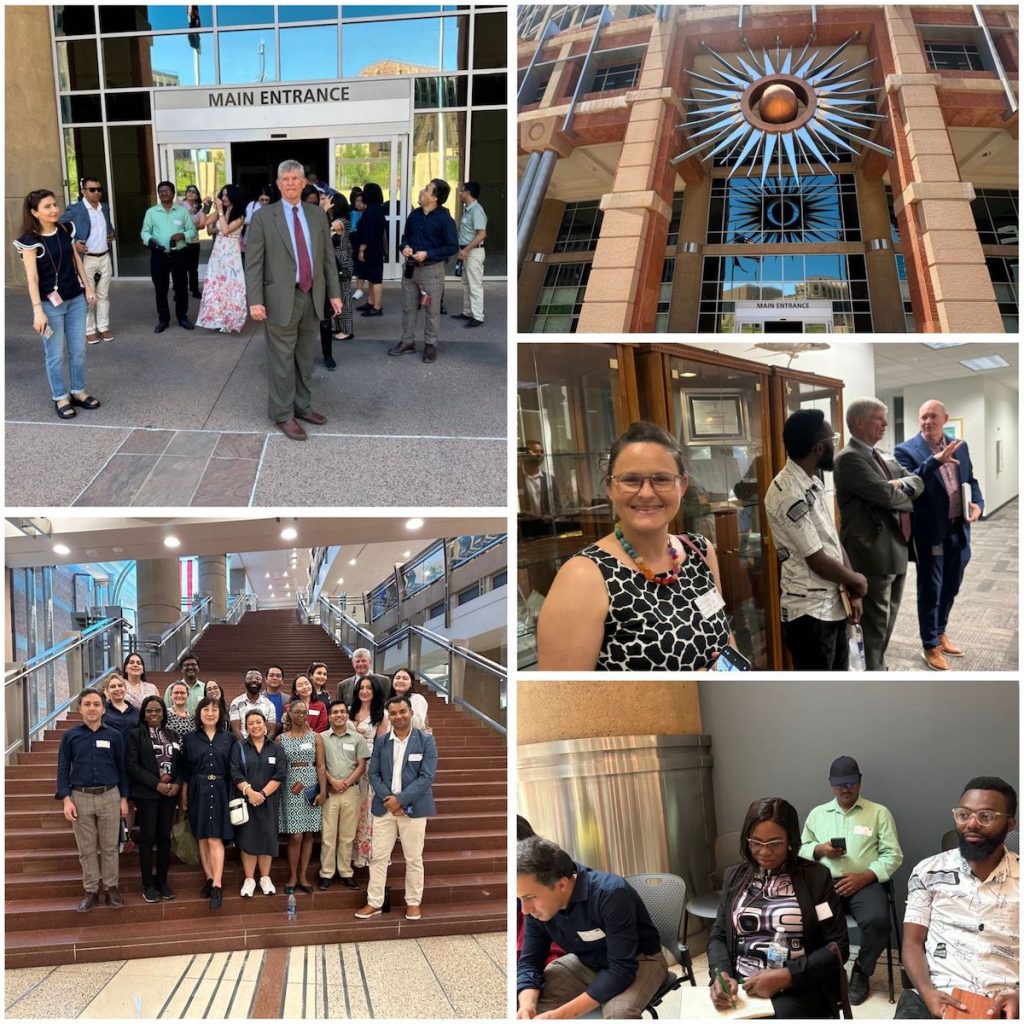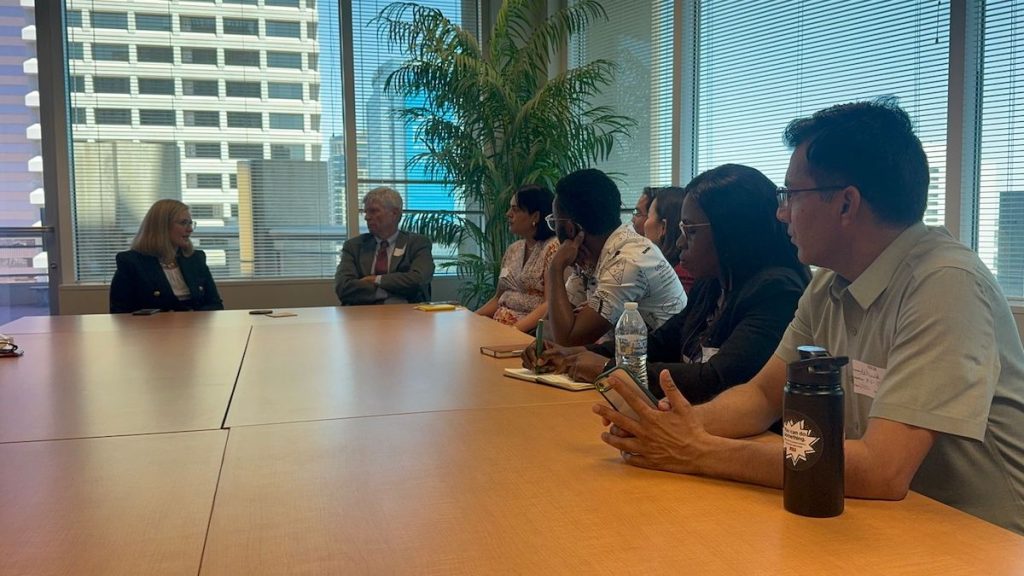One of our deliverables as program participants is writing blog posts. Dr. Dawn Gilpin had front loaded the schedule; and on Tuesday June 18, I was on duty. In making a decision about how to approach my story. I chose to turn our attention to Phoenix because our scheduled visit to the “big deal,” was targeted at achieving one of the objectives of the Study of the U. S. Institutes (SUSIs), that is to allow participants learn about and experience U.S. culture and society. Our visit to the “big deal” afforded me the opportunity to learn more about the U.S., commonly described as a bastion of democracy. In particular, I was interested in how political office holders improve the quality of life for constituents. Anyway, before I get down to the brass tacks of writing the story, let me whet your appetite with my remarkable journey to SUSI.
SUSI Scholar by divine providence in God’s time
Although I have had different fellowships and study grants from various countries and organizations such as ELF Petroleum Coy Ltd.; the British government under the auspices of the Chevening Scholarship; African Association of Political Science, (AAPS)/Harry Frank Guggenheim (HFG) Foundation; Council for the Development of Social Science Research in Africa (CODESRIA) and ADM Erasmus+, I was still desirous of this U.S. opportunity.
So I stayed on the look out for a good scholarly opportunity that would expose me to the U.S. educational system and give me the opportunity to upskill at one of the country’s universities, not discounting immersion in the rich culture of the American people. At one point, I had a conversation with the late Professor Ayo Olukotun, a renowned political scientist, media scholar, and columnist who mentored me on newspaper editorial writing. He said, “Don’t worry: one day, America will come for you.” That statement has turned out to be prophetic since America came for me through the relevant sections of the United States Consulate in Lagos, Nigeria, who routinely publicize educational opportunities using different communication platforms/channels, when they publicized the Study of the United States Institutes (SUSI) call for applications.
So I completed the form and submitted, though I kept an open mind. On Thursday, March 28, 2024, around mid-morning, I received a call from an unknown number, and I took the call. The caller asked if he was speaking with Abigail Ogwezzy-Ndisika, and I responded in the affirmative. Then he asked, “Are you expecting the outcome of your SUSI application?” I said yes. He continued, “Sorry to disappoint you…” I cut in and said, “No worries.” However, before I finished speaking, he continued, “…and congratulations! You made it and we will give you formal written notification.”
So it was a pleasant (though dramatic) surprise. As such, America came for me by divine providence.
Although I am not privy to the paperwork done by the relevant sections of the U.S. Consulate in Lagos to support my application for the Journalism & Media cohort and those of other successful candidates across the other five streams of the SUSI program, I want to place it on record that I am grateful because the SUSI program is very competitive: only 18 of us were chosen globally for my cohort. On July 13 the U.S. will deliver these 18 scholars and experts to the world, with its attendant multiplier effect as we serve our countries. The emotion I feel strongly now is gratitude to the United States government for investing in human capital, globally.
Visit to the “big deal“
On June 18 and with Daniel Barr, our lead facilitator for the third week of the program in attendance, our morning session focused on government relations. Mr. Richie Taylor, Communications Director for the Arizona Attorney General Kris Mayes, facilitated the discussion on the role of strategic communication and government relations within the state judicial and political system.
After this session, Barr took us through the United States legal protections for journalists using the First Amendment in the Constitition as an entry point and Branzbury V. Hayes (1972) as a precedent. He submitted that journalists have qualified protection because the First Amendment is not violated by (1) requiring a reporter to testify before a grand jury to answer questions pertaining to an investigation into the commission of a crime; and (2) otherwise disclosing information that the reporter obtained in confidence relevant to such investigation. Aptly, Barr who is the Chief Deputy Attorney General for the State of Arizona and a seasoned media and First Amendment Attorney, reminded us that journalist protection is not absolute! This calls for journalists and media professional to be socially responsible in the discharge of their duties because the rule of law must prevail.

After the first two sessions for the day, Bar announced that we would go on a short break and reconvene in the lobby of the Cronkite School at 1 pm to walk over to City Hall. There we were scheduled to meet with Phoenix mayor Kate Gallego and members of her staff to discuss municipal governance and press relations as stated in our program booklet. Given that the walk is estimated to take 14-15 minutes, Barr requested that we reconvene promptly to get to our destination on time by 1:30, given that we would have to undergo security checks and protocols. We all complied.
As we walked the streets of Phoenix to City Hall to meet with our host, Mayor Gallego, Barr kept referring to her as a “big deal.” That aroused my curiosity and set my development antenna alert to prompt our host and tilt the conversation around the development of Phoenix in order to unravel how Barr came to this “big deal” designation.
Upon arrival at our destination, we were greeted by a team of diverse security personnel and front desk staff. The female security personnel requested evidence of our appointment to meet with the Mayor and Barr pull out his telephone. He scrolled through and showed the evidence to the female security. We all went through the scanners and walked to the front desk, where we were asked to write our names. Using the list of names, the front desk team quickly issued each of us a flexi name tag that included the date, entry time and the meeting floor: the 11th floor in a magnificent 20-floor building.

At the 11th floor was a female receptionist to the Mayor, who asked if anyone wanted water. Those who indicated interest were each given a bottle of water. For anyone who knows the temperature of Phoenix during summer, water is the currency for healthy living! As such, we had a warm welcome. Not long afterwards, Mayor Kate Gallego walked in with a charming smile and in the company of her Press Secretary. Again, we felt honoured that she found time to share her policies and actions towards delivering future Phoenix with us.
As she was ushering us into her meeting room, her Press Secretary and the photographer quickly prompted her that we should have a photograph before the meeting, which we did. From there, we moved to her meeting room. Then Barr formally introduced the Mayor to us and she requested we individually introduce ourselves. We all did, including our countries of origin.
Then, Barr restated the purpose of our visit to Kate Gallego and her Press Secretary, saying that the visit was to discuss municipal governance and press relations. Given that the Mayor has dedicated herself to public service, having served on the Phoenix City Council for many years, the focus was on creating the Phoenix of the future and positioning it as a welcoming, thriving city with ample high-wage jobs and opportunities for all. Without any prepared speech, she kicked off the conversation in an emotion laden voice that revealed her passion for building a Phoenix that works for everyone and improving the quality of life for all Phoenicians.

In her quest for a future Phoenix, the Mayor spoke about how she focused her energies on diversifying the economy, strengthening infrastructure investment, working to make Phoenix a leader in sustainability, and ensuring that public health is protected by adhering to the evolving science around the COVID-19 virus.
During the conversation she shared details about how she brought a historic $65 billion semiconductor manufacturing plant to Phoenix that is creating thousands of great-paying career paths; built coalitions to deliver critical improvements to parks, public safety, and city infrastructure; and her partnership with ASU to build a brand-new medical school in downtown Phoenix.
On the topic of environment and water, Mayor Gallego said that under her watch, the water conservation ordinance geared towards large water users was approved, which is a major component of the “Sustainable Desert Development Policy” that has become a law.
Again, the Mayor explained that she matched policy and law with action through social and behavior change communication (SBCC) intervention with the “Save Water Pledge” campaign, being a part of a broader initiative to ensure Phoenix remains a sustainable desert city, and the campaign to pass Phoenix’s citywide transportation plan through 2050–the largest local government commitment to transportation infrastructure in the country. She also led efforts on criminal justice reform and ensuring equal pay for equal work.
At this juncture, one of my colleagues raised the issue of homeless people in Phoenix, the Mayor frankly admitted it is one of the major social issues in the city and she is not oblivious to it, neither did she and her team cast a blind eye to the issue. Instantly, the Mayor reeled out the interventions being used to address the issue and used data to buttress her position, stressing that the number of individuals who are unsheltered in the City of Phoenix is declining because of a series of investments by the City Council in funding more shelter beds.
After the conversation, it became obvious to us that delivering future Phoenix is in the Mayor’s DNA, and Barr was right to have described the Harvard-trained Mayor of Phoenix, the 5th largest city in the nation, one of the youngest big-city mayors in the United States, and the second elected woman Mayor in Phoenix history as a “big deal.”
